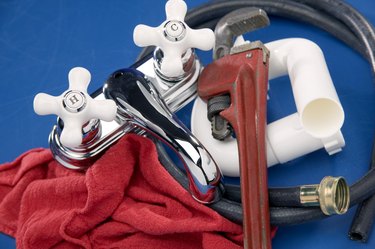
Poly vinyl chloride, or PVC, is a material manufactured for applications such as pipe systems for residential and industrial settings. PVC is strong, lightweight and proven to be extremely durable for many years, according to the Plastic Pipe and Fittings Association. PVC pipes are connected by a variety of PVC joints, including spigots.
Definition
Video of the Day
A spigot is generally the male end of a PVC pipe fitting, which connects by attaching inside the other PVC pipe or joint. So, essentially, a spigot connects two PVC pipes or joints. Spigots can be used in different PVC pipe-fitting applications.
Video of the Day
Threaded or Slip Socket
A threaded spigot has threads inside the fitting to screw into the PVC joint, referred to as a spigot by FPT -- female pipe threads. Part of the spigot slides into a PVC pipe or joint, and another pipe is threaded into the spigot. A slip socket spigot has no threads and slides into the joint.
Uses
PVC pipes used in some applications require areas of the system of pipes to increase or decrease in size. Spigots not only connect joints, they connect large PVC pipes to smaller pipes. These spigots are referred to as reducer bushings. Spigots are also used for curved fittings to create a 90-degree angle in a PVC piping system.
Application
Although spigots connect easily, they're also bonded to the PVC pipe or joint. Slip socket spigots are welded using PVC solvent cement. Solvent cement is applied to the outside of the spigot, and the spigot is inserted into the PVC pipe or joint. On threaded spigots, Teflon tape is used on the male threads before connecting it to the joint. The Teflon tape is wrapped around the male thread, then screwed into the joint to ensure a secure connection.